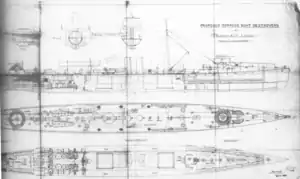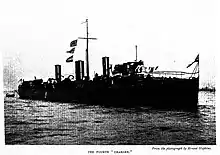HMS Charger (1894)
HMS Charger was a Charger-class destroyer which served with the Royal Navy. She was launched by Yarrow Shipbuilders at Poplar, London on 15 September 1894,[1] served in home waters and was sold off in 1912.
 Plans for the Charger class | |
| History | |
|---|---|
| Name: | HMS Charger |
| Builder: | Yarrow Shipbuilders, Poplar, London |
| Laid down: | November 1893 |
| Launched: | 15 September 1894 |
| Completed: | February 1896 |
| Fate: | Scrapped, 1912 |
| General characteristics | |
| Class and type: | Charger-class destroyer |
| Displacement: | 255 long tons (259 t) |
| Length: | 195 ft (59 m) |
| Beam: | 18.5 ft (5.6 m) |
| Draught: | 7.25 ft (2.2 m) |
| Propulsion: |
|
| Speed: | 27 knots (50 km/h; 31 mph) |
| Armament: | |
Construction and design
On 12 October 1893, the British Admiralty placed an order for three torpedo boat destroyers (Charger, Dasher and Hasty) with the shipbuilder Yarrow under the 1893–1894 shipbuilding programme for the Royal Navy as a follow-on to the two prototype destroyers (Havock and Hornet) ordered from Yarrows under the 1892–1893 programme.[2][lower-alpha 1]

The Admiralty did not specify a standard design for destroyers, laying down broad requirements, including a trial speed of 27 knots (31 mph; 50 km/h), a "turtleback"[lower-alpha 2] forecastle and armament, which was to vary depending on whether the ship was to be used in the torpedo boat or gunboat role.[5] As a torpedo boat, the planned armament was a single QF 12 pounder 12 cwt (3 in (76 mm) calibre) gun on a platform on the ship's conning tower (in practice the platform was also used as the ship's bridge), together with a secondary gun armament of three 6-pounder guns, and two 18 inch (450 mm) torpedo tubes. As a gunboat, one of the torpedo tubes could be removed to accommodate a further two six-pounders.[6][7]
Yarrow's design was 195 feet 0 inches (59.44 m) long overall and 190 feet 8 inches (58.12 m) between perpendiculars, with a beam of 18 feet 6 inches (5.64 m) and a draught of 11 feet 3 inches (3.43 m). Displacement was 255 long tons (259 t) light and 295 long tons (300 t) full load. Two locomotive boilers fed steam at 180 pounds per square inch (1,200 kPa) to two three-cylinder triple expansion engines.[8] The machinery was rated at 3,000 indicated horsepower (2,200 kW).[9] Two funnels were fitted.[8]
Charger was laid down at Yarrow's Poplar, London shipyard in November 1893 as Yard number 991 and was launched on 15 September 1894.[8] She reached a speed of 27.98 knots (32.20 mph; 51.82 km/h) during sea trials,[10] and was completed in January 1896, at a cost of £41,133.[8] Locomotive boilers were being made obsolete by water-tube boilers by the time of her completion, and she was refitted at Earle's Shipbuilding in 1899–1890 with water-tube boilers changing to a three-funneled configuration.[8]
Service history
In 1896 Charger was in reserve at Portsmouth.[11] In July 1901, she took part in that year's Naval Manoeuvres.[12] Charger was commissioned at Devonport by Lieutenant Robert William Francis Travers on 11 March 1902,[13] for service with the Devonport instructional flotilla.[14] Travers was reassigned to the battleship Nile the following month, when Lieutenant G. H. Brown was appointed in command of Charger.[15] She took part in the fleet review held at Spithead on 16 August 1902 for the coronation of King Edward VII.[16] On 23 September 1903, Charger struck rocks in Loch Nevis on the West coast of Scotland.[17]
Charger was refitted at Sheerness dockyard in 1908, having her boilers re-tubed.[18] Charger, now part of the Sixth Destroyer Flotilla, was again refitted at Sheerness in August 1911.[19]
Charger was sold at Chatham to the shipbreaker Ward on 14 May 1912 for scrapping at their Silvertown works, at a price of £1600.[8][20]
Notes
- Three more destroyers were ordered from Thornycroft on the same date, while a further 30 destroyers were later ordered from other shipbuilders under the same programme.[3]
- A fore deck with exaggerated camber designed to throw off sea water at high speeds.[4]
Citations
- The Times (London), Monday, 17 September 1894, p.8
- Lyon 2001, pp. 40, 43
- Lyon 2001, p. 19
- Gardiner & Lambert 1992, p. 188
- Lyon 2001, p. 20
- Lyon 2001, pp. 98–99
- Friedman 2009, p. 40
- Lyon 2001, p. 56
- Friedman 2009, p. 290
- Brassey 1897, p. 321
- "Naval Matters: Past and Prospective: The Reserve of Ships and Men". The Marine Engineer. Vol. 18. July 1896. p. 155.
- Brassey 1902, pp. 86–87, 90–91
- "Naval & Military intelligence". The Times (36720). London. 20 March 1902. p. 10.
- "Naval & Military intelligence". The Times (36713). London. 12 March 1902. p. 7.
- "Naval & Military intelligence". The Times (36747). London. 21 April 1902. p. 6.
- "Naval Review at Spithead". The Times (36847). London. 15 August 1902. p. 5.
- "Maritime Intelligence: Charger (H.M.S)". Shipping Gazette and Lloyds List. 26 September 1903. p. 10. Retrieved 1 February 2021 – via British Newspaper Archive.
- "Naval Matters—Past and Prospective: Sheerness Dockyard". Vol. 30. May 1908. p. 402. Cite magazine requires
|magazine=(help) - "Naval Matters—Past and Prospective: Sheerness Dockyard". Vol. 34. August 1911. p. 15. Cite magazine requires
|magazine=(help) - Lecky 1913, p. 45
Bibliography
- Brassey, T.A. (1897). The Naval Annual 1897. Portsmouth, UK: J. Griffin and Co.CS1 maint: ref=harv (link)
- Brassey, T.A. (1902). The Naval Annual 1902. Portsmouth, UK: J. Griffin and Co.CS1 maint: ref=harv (link)
- Chesneau, Roger & Kolesnik, Eugene M., eds. (1979). Conway's All The World's Fighting Ships 1860–1905. London: Conway Maritime Press. ISBN 0-85177-133-5.CS1 maint: ref=harv (link)
- Friedman, Norman (2009). British Destroyers: From Earliest Days to the Second World War. Barnsley, UK: Seaforth Publishing. ISBN 978-1-84832-049-9.CS1 maint: ref=harv (link)
- Gardiner, Robert & Gray, Randal, eds. (1985). Conway's All The World's Fighting Ships 1906–1921. London: Conway Maritime Press. ISBN 0-85177-245-5.CS1 maint: ref=harv (link)
- Gardiner, Robert; Lambert, Andrew, eds. (1992). Steam, Steel & Shellfire: The Steam Warship 1815–1905. Conway's History of the Ship. London: Conway Maritime Press. ISBN 0-85177-564-0.CS1 maint: ref=harv (link)
- Lecky, Halton Sterling (1913). The King's Ships: Vol II. London: Horace Muirhead.
- Lyon, David (2001). The First Destroyers. London: Caxton Editions. ISBN 1-84067-3648.CS1 maint: ref=harv (link)
- Manning, T.D. (1961). The British Destroyer. London: Putnam. OCLC 6470051.CS1 maint: ref=harv (link)